Do you have a question about the Optoma Projector and is the answer not in the manual?
Details about electrical hazards, symbols, and general safety instructions.
Important warnings and precautions for using the projector safely and correctly.
Guidance on avoiding direct exposure to the projector beam to protect eyesight.
Lists key features and specifications of the projector.
Lists the contents of the projector box and instructions for checking them.
Provides a visual overview of the projector's main unit and its components.
Details the buttons and functions of the projector's control panel.
Diagram and list of all physical ports for connecting external devices.
Identifies buttons and functions of the projector's remote control.
Explains the features, operation, and battery installation of the interactive pen.
Illustrates how to connect various cables to the projector for initial setup.
Shows how to connect different video sources like DVD players and set-top boxes.
Step-by-step guide on how to turn the projector on and off.
Procedure for safely shutting down the projector and its cooling cycle.
Explains the meaning of different LED indicators and automatic shutdowns.
Instructions for using elevator feet to adjust the projector's vertical position.
Guide on how to rotate the focus ring to achieve a clear image.
Details on how to change the size of the projected image.
Description of the projector's physical control panel and its button functions.
Explanation of how to use each button on the projector's remote control.
Details on using the interactive pen's features like mouse clicks and menu navigation.
Explains how to access the help menu for setup and operation assistance.
Describes when the help menu is active and common troubleshooting scenarios.
Guide on using the Presenter application via a wired LAN connection.
Instructions for using the Presenter application wirelessly.
Explains how to navigate and use the projector's on-screen display menus.
Hierarchical overview of the projector's OSD menu structure for settings.
Description of various factory presets for optimizing image display.
How to adjust the overall brightness of the projected image.
How to adjust the difference between the lightest and darkest parts of the image.
How to adjust the sharpness of the projected image.
How to adjust the color saturation of the video image.
How to adjust the color balance between red and green tones.
Advanced image settings including Gamma, Color Temp, and Color Settings.
How to select the appropriate color matrix type (AUTO, RGB, YUV).
How to enable or disable specific input sources for the projector.
Options for choosing the desired aspect ratio for the projected image.
Removes noise from video images, especially on the edges.
Adjusting image size and horizontal/vertical position.
Correcting vertical image distortion for rectangular projection.
Settings for enabling and configuring 3D display modes.
Option to invert left and right frame contents for 3D display.
Configuration settings for Language, Screen Type, and Projection mode.
Setting the OSD menu position and assigning a unique projector ID.
How to turn the audio output on or off.
Adjusting audio volume and reassigning audio inputs to video sources.
Settings for automatic signal detection and manual adjustment of Phase/Frequency/Position.
Configuring security verification, timer, and password changes.
Settings for startup logo, logo capture, and closed captioning.
Setting up network parameters like DHCP, IP Address, Subnet Mask, and Gateway.
Instructions for controlling the projector remotely via a web browser.
Overview of the Crestron RoomView software for managing projectors.
Settings for Source Lock, High Altitude, Information Hide, Keypad Lock, Background Color, IR Receiver.
Settings for Direct Power On, Auto Power Off, Sleep Timer, and Power Mode.
Displays lamp hours, sets lamp reminders, brightness modes, and resets lamp counter.
Configuration options for interactive features like Dual Pen and Pointer Motion.
Introduction to Ruby project for high-performance network projection.
Guide on using the Web Control application for remote projector configuration.
Viewing system information and changing web page passwords.
Detailed options for controlling projector functions like power, source, and brightness.
Setting up error alerts and configuring email sending for notifications.
Configuring network parameters including IP, DHCP server, and wireless settings.
Setting user/admin passwords and managing network display connections.
Using the Flash UI for controlling projector power, volume, and source.
Basic network info, projector ID, user password, DHCP, and admin password settings.
Restoring projector settings to factory defaults and performing firmware upgrades.
Instructions on how to restart the projector system.
Guide to displaying images from a USB flash drive using the card reader function.
Using the Optoma Presenter application for remote desktop display over network.
General guide to diagnosing and resolving common projector problems.
Resolving issues with image display, flickering, and notebook connectivity.
Resolving focus, stretching, size, slant, and reversed image issues.
Troubleshooting projector unresponsiveness and understanding LED status lights.
Interpreting warning messages and troubleshooting remote control functionality.
Steps to resolve issues when the interactive pen is not working correctly.
Important warnings and precautions before replacing the projector lamp.
Step-by-step instructions for safely removing and installing a new projector lamp.
List of supported resolutions and refresh rates for various computer video modes.
Information on supported video standards like NTSC, PAL, SECAM, SDTV, and HDTV.
Diagram and description of the projector's RS232 connector pinout.
List of RS232 commands, their HEX codes, and functions.
Specifications and guidelines for safely mounting the projector on a wall or ceiling.
Contact information for Optoma service and support offices worldwide.
Information regarding the device's compliance with FCC rules for digital devices.
FCC operation conditions, Canadian notices, and EU conformity declarations.
Guidelines for environmentally responsible disposal of the electronic device.
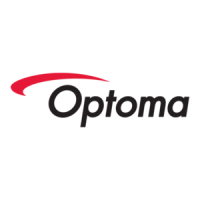
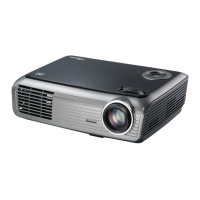

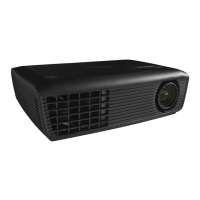
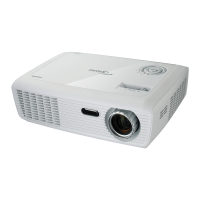
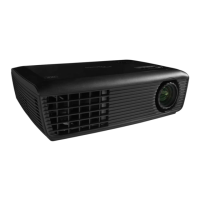


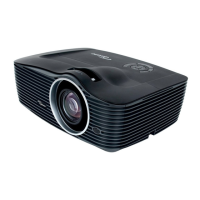
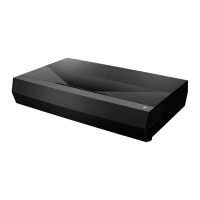

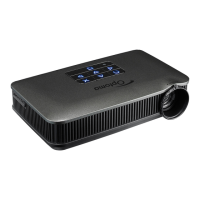
